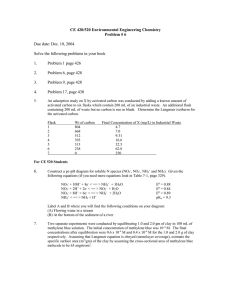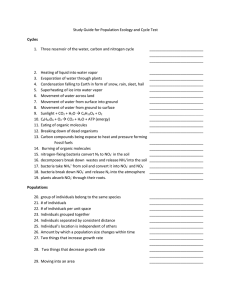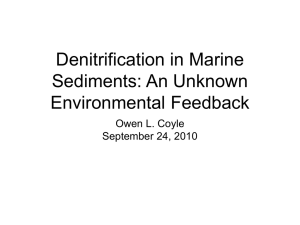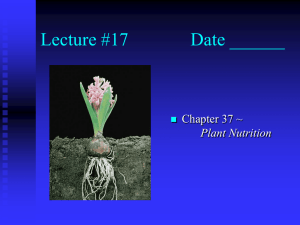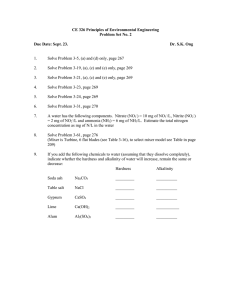Nutrients and Biological Productivity 12.097 Lecture January 17, 2006
advertisement
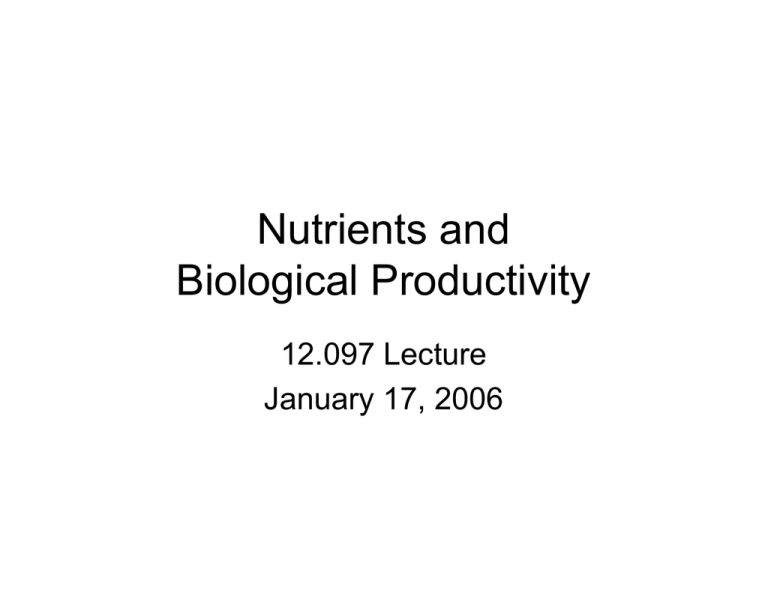
Nutrients and Biological Productivity 12.097 Lecture January 17, 2006 What is a “nutrient”? • An element or compound that is beneficial or required for biological growth • “Essential” nutrients are those that are required for growth – i.e., everything dies if the concentration drops below a threshold • Major: nitrogen (N), phosphorus (P) – silica (Si), sulfur (S) [not for all organisms] • Minor: trace metals (e.g., Fe, Co, Mn, Zn), vitamins (e.g., B12) What concentrations are required? • Stoichiometry of life: Redfield ratio – Empirical ratio of phytoplankton collected from various ocean and lake environments – C:N:P = 106:16:1 – The “limiting” nutrient is the one which is in lowest concentration relative to the other two – In freshwater systems, P is limiting nutrient – In marine systems, N is limiting nutrient (though this varies widely in coastal vs. open-ocean systems) How do organisms acquire nutrients? Uptake rate of nutrients is described by MichaelisMenten kinetics. V = velocity of uptake rate Vmax = maximum velocity S = substrate concentration KS = substrate concentration at V = ½ Vmax Nearly linear at small [S] Nearly flat at high [S] Image removed due to copyright considerations. Please see: http://www.steve.gb.com/science/enzymes.html V = Vmax S KS + S N and P • Different “sizes”: dissolved and particulate – Dissolved = in aqueous solution – Particulate = associated with particles (surfaceadsorbed, imbedded within, etc.) • Different “forms”: inorganic and organic – N: NH4+, NO2-, NO3-, urea, proteins, nucleic acids – P: PO4-3 (+ HPO4-2, H2PO4-, H3PO4), phospholipids, nucleic acids • Oxidation states – N: N(V) in NO3-, N(0) in N2, N(-3) in NH4+ – P: P(V) in PO4-3, other redox states insignificant The Marine P Cycle: Depth Profile • Depleted at surface (biological uptake) • Remineralized during heterotrophic activity (~1000m and sediments) • Remineralization is Temp-dependent (max in spring in coastal areas) Images from eWOCE removed due to copyright considerations. The Marine P Cycle: Surface Variability Image removed due to copyright considerations. Please see: Levitus 1994. (See readings.) The Marine P Cycle • Abiotic reactions: – Adsorption to positive-charged minerals (e.g., clays) – Complexation with metals (e.g., Fe+3, Al+3, Ca+2) • Biotic reactions: – Uptake by phytoplankton & bacteria • Sources: – Continental weathering of Pcontaining minerals – Anthropogenic activity (soap) Î River runoff (~90%) • Sinks: – Burial of particulate material (cells, minerals) in sediments – Sea bird guano • τres of diss. PO4-3: 1-2 min Image removed due to copyright considerations. Please see: Valiela, 1995 (Marine Ecological Processes) (See readings.) The Marine N Cycle: Depth Profile Very similar behavior to PO4-3 Depleted at surface; remineralized at depth Deep water is a source of NO3- to surface ocean (via upwelling) NH4+ and NO2- follow similar depth profiles (though much lower conc’s) [DON] >> [DIN] Image removed due to copyright considerations. The Marine N Cycle: Surface Variability Image removed due to copyright considerations. Please see: Levitus 1994. (See readings.) The Marine N Cycle • Many more reactions in N cycle than in P cycle – • • Due to possible changes in redox state, presence of gaseous component (N2) No abiotic reactions Biotic reactions: – NO3- reduction: • Assimilatory (N used in biosynthesis) • Dissimilatory (N not used in biosynthesis) = Denitrification – NH4+ oxidation • Sources: – N2 fixation (anthro & natural) – River runoff – Sewage • Sinks: – Biological uptake by cells – Burial in sediments Image removed due to copyright considerations. Please see: Valiela, 1995 (Marine Ecological Processes) (See readings.) The Marine N Cycle Dissolved N2 Nitrogen fixation Particulate N Surface ocean Deep ocean NH4+ DON Assimilation Nitrification NO3NH 4+ Water column denitrification Burial of organic matter Courtesy of Karen Casciotti. Used with permission. NO3Vertical mixing/ upwelling Sedimentary denitrification Microbial N Cycle Nitrogen fixation NO Anammox Org.N NH3 Denitrification N2 O N2 Assimilation NO2- NO3- Nitrite oxidation Nitrification NH2OH Ammonia oxidation N redox State: (-III) (-I) (0) (I) Courtesy of Karen Casciotti. Used with permission. (II) (III) (V) N transformations in presence of O2 • • • • Assimilatory NO3- reduction: NO3- Æ NH4+ NH4+ is most bioavailable form due to biosynthesis needs (e.g., proteins & nucleic acids) Organisms prefer NH4+ uptake rather than NO3- due to E requirement of NO3- reduction NH4+ is primary remineralization product of zooplankton and other heterotrophs Æ this can be largest source of N for phytoplankton and bacteria in open ocean (low nutrient environments) • Nitrification (oxidation of N): – NH3 + 3/2 O2 Æ NO2- + H2O + 2H+ – NO2- + ½ O2 Æ NO3– Steps 1 and 2 performed by different organisms (e.g., Nitrosomonas and Nitrospira) – Require conservative enzymes such as ammonia monooxygenase (AMO) – Requires O2 but can occur at low [O2] – Reduces CO2 to organic C – Maximum rate at ~150m in open ocean Anoxic N transformations • Denitrification (reduction of N): • Anammox (oxidation and reduction of N): – NH4+ + NO2- Æ N2 + 2 H2O • • • • • Organic C is oxidized to CO2 Requires 0 or low [O2] Important organisms: heterotrophic bacteria Enzymes are highly conserved and membrane-bound (e.g., nitrate reductase) Largest sink of N in estuaries (15-71%) = 4-5X N2-fixation • • • • Newly discovered process occurring in bacterial order Planctomycetales Potential cellular system: Anammoxosome Seen in anoxic zones of Black Sea, wastewater treatment plants Rates and prevalence unknown Nitrogen fixation • N2-fixation (reduction of N): – N2 Æ NH4+ • • • Requires high [Fe+2] and 0 or low [O2] – cells often have anoxic microzones to reduce local [O2] Inhibited by high [NH4+] Important organisms: Trichodesmium, Oscillatoria Image removed due to copyright considerations. Please see: http://www.imagequest3d.com/catalogue/freshwater/pages/u013_jpg.htm Anthropogenic impact on N2 fixation: Currently = natural fixation N contamination in coastal env’s Image removed due to copyright considerations. Please see: http://www.msnbc.msn.com/id/4624359/ • Excess N in groundwater and rivers leads to eutrophication of coastal zones • Destroys existing habitats (promotes anoxia) • Particularly problematic in regions with septic systems What does it all mean for the productivity of the ocean? Courtesy of Karen Casciotti. Used with permission. SEAWIFS data from K. Casciotti Productivity: Definitions • Important value because it is major mechanism by which surface ocean and atmospheric [CO2]’s are maintained at 2X lower than expected. • Gross primary production (GPP): – Input of energy and organic matter into ecosystem – Equals all photosynthetic production • Photoassimilation: – GPP – rate of O2 production associated with photorespiration • Net primary production (NPP): – Rate of photoassimilation – rate of dark respiration (heterotrophs) • f ratio – New production / total production • Depends on light (hυ), nutrient concentrations, T (small) Light Image removed due to copyright considerations. Please see: http://www.lifesciences.napier.ac.uk/teaching/Eu/CDonly.gif Image removed due to copyright considerations. Please see: http://www-ocean.lbl.gov/seawifs/9712SeaWiFS.html
